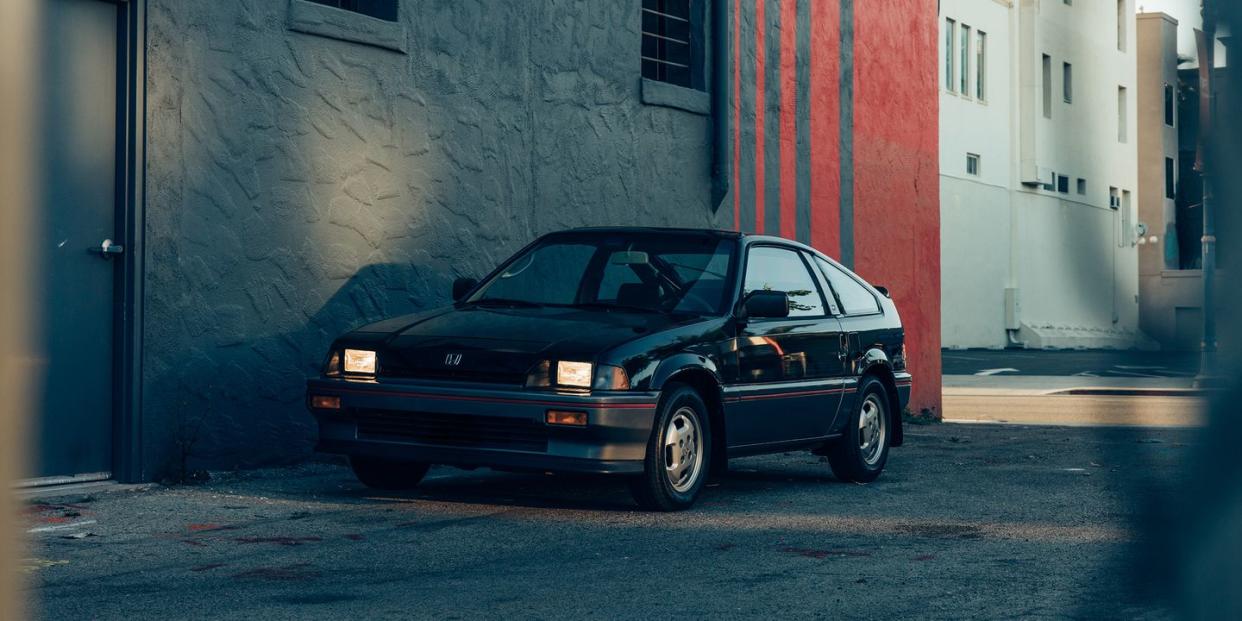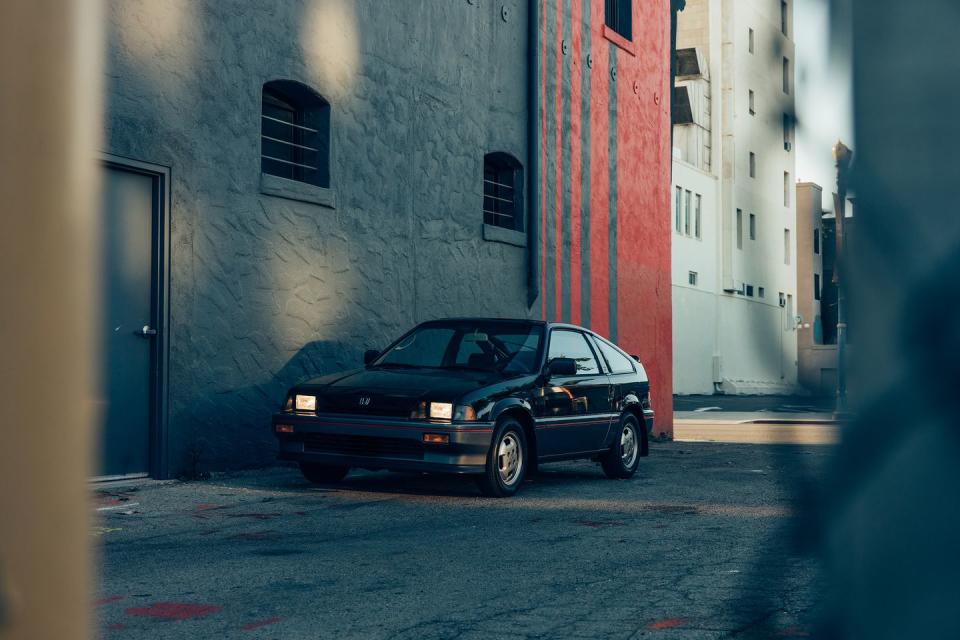The Honda CRX Si Is the Antidote to Modern Bloat


“I first drove a friend’s non-Si CRX at an autocross in 1984,” recalls fabled Honda racer Peter Cunningham. “It was so good. It had great handling and balance and a good power-to-weight ratio. So, on June 28, 1986, I leased a CRX Si for four years. And when I wasn’t racing it, I was using it to tow my other race car.”
This story originally appeared in Volume 12 of Road & Track.
SIGN UP FOR THE TRACK CLUB BY R&T FOR MORE EXCLUSIVE STORIES
In the early Eighties, most new cars had carburetors. In 1980, the only Ferraris the factory sent to America were the 308 and the Mondial, both powered by a carbureted 3.0-liter V-8 with 205 hp. The Toyota Corolla was rear drive with a solid axle through 1983. Chevrolet sold the antediluvian Chevette until 1987, and the 1981 Ford Mustang’s only V-8 was a 4.2-liter rated at 115 hp. The Germans? VW’s GTI didn’t make it here until 1984, and from 1982 through 1985, the only way to buy a mid-size Mercedes-Benz (the now-beloved W123) was with a diesel engine. The two-seat CRX Si looked like half a hard-boiled egg, never generated huge performance numbers, and didn’t sell in enormous quantities, but it was the vanguard of every coming good thing.
This 1985 example is, literally, a museum piece. American Honda delivered it to us to drive in Santa Barbara, California, so we could reminisce on the prescience of what is now a time capsule. It’s likely as well preserved as any first-year CRX Si there is. Showing barely over 10,000 miles on the odometer, it’s spooky stock. Thirteen-inch aluminum wheels inside cheap P175/70R-13 tires. No stupid Maxwell House exhaust tip or gnarled suspension pieces. A survivor that has slalomed around bad mods for 37 years.

Some redecoration separated the Si from the lowly versions of the CRX (for example, a trick sunroof that rolled back atop the roof), but what mattered was the fuel-injection system.
Honda built its own electronic fuel injection for the Si and paired it with a new tuned-runner intake manifold. Honda’s Programmed Fuel Injection (PGM-FI) was first used on the company’s CX500 and CX650 Turbo two-cylinder motorcycles, where its precise fuel metering civilized the turbo installation for on-road manners. Using sophisticated piezoelectric sensors and some computer logic, it bumped output of the CRX’s SOHC 12-valve 1.5-liter four from 74 hp with a carb to a full 91. Those small numbers figure out to a 23 percent increase in output. For a car that cost as little as the CRX Si—$7999 to start, or about $22,000 in current dollars—injection was advanced tech.

“Little,” though, is relative—that price was over $1000 higher than the carbureted base CRX.“Little” is also an absolute term. Approach the CRX now and it seems impossibly dinky. Ford sells the 2022 F-150 in five wheelbases, three of which are lengthier than the CRX is long overall. At 1840 pounds, the CRX Si weighs in more than half a ton (1121 pounds) lighter than the 2022 Civic Si sedan with summer tires. If you could stack the min through the hatch, that’s four Aaron Donalds plus a pound of jerky.
The trick part of the CRX design is that almost all 86.6 inches of its wheelbase are used to accommodate the two passengers. There’s real stretch-out room, and the base of the windshield reaches almost to the front wheels’ trailing edge. That’s possible thanks in part to a front suspension that’s low because of a design using struts with torsion bars that extend below the floor pan. Also adding to the roomy feeling are thin door panels and a dash design that falls away down to the passengers.

Roominess isn’t always the same as comfort. There Honda made it all work by including seats shaped to fit human bodies, a steering wheel that’s sized for human reach and grip, and pedals placed in wells that can deal with human feet.
To Honda’s advantage, it was designing the CRX before VistaVision screens on dashboards and dozens of additional regulations like airbag mandates. Honda could be simple back then because of the simpler times.
While the engine’s character is sweet, it doesn’t produce much torque, rated at a peak of only 93 lb-ft at 4500 rpm. To get moving, it must be thrashed. That also means the old CRX Si is geared to stay in the meat of the powerband, running at 3000 rpm or higher at typical freeway speeds. Today turbocharged small-car engines produce oceans of torque compared with this old puddle. They can relax when cruising and rack up big EPA mileage ratings.

Keep the weight difference in mind and the gap in EPA ratings is stark. Using current measurement standards, the old CRX Si is rated at 26 mpg in the city and 32 mpg on the highway. Meanwhile, the gargantuan new Civic Si sedan bumps those numbers to 27 in the city and 37 on the highway. The current Civic Si also rips to 60 mph in 6.8 seconds, with the quarter-mile going by in 15.1 seconds at 94 mph. The old CRX Si needed 9.1 seconds to reach 60 and 16.4 seconds to run the quarter at81 mph. What the pair has in common is brilliant transmissions—perfect-shifting five- and six-speed manuals. That Honda tradition of sweet-shifting manuals is one worth sustaining forever.
The windup windows on the ’85 model are no problem, but when it’s time to park, the manual steering is kind of a hassle. Still, even after 37 years, the communication of the steering is astonishing. There’s no reason for exotic tires, as long as what matters is actual fun. And no, speed doesn’t necessarily equate to fun.

The CRX Si is still a good idea. Honda should be chopping down the current Civic into one right now. A 2023 CRX Si with a 90-inch wheelbase and a 2700-pound curb weight carrying the current 200-hp turbocharged 1.5-liter engine would be spectacular.
After the CRX Si, the world changed. Injection came to everything, the sport-compact craze ignited, and Peter Cunningham went on to win 14 championships in various series. His first was in 1987, in Pro Ice Endurance racing, in a CRX Si.
You Might Also Like

 Yahoo Movies
Yahoo Movies 
